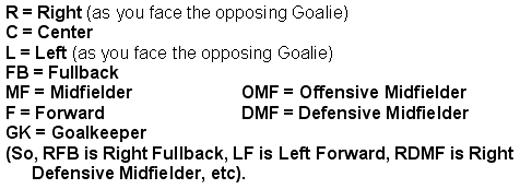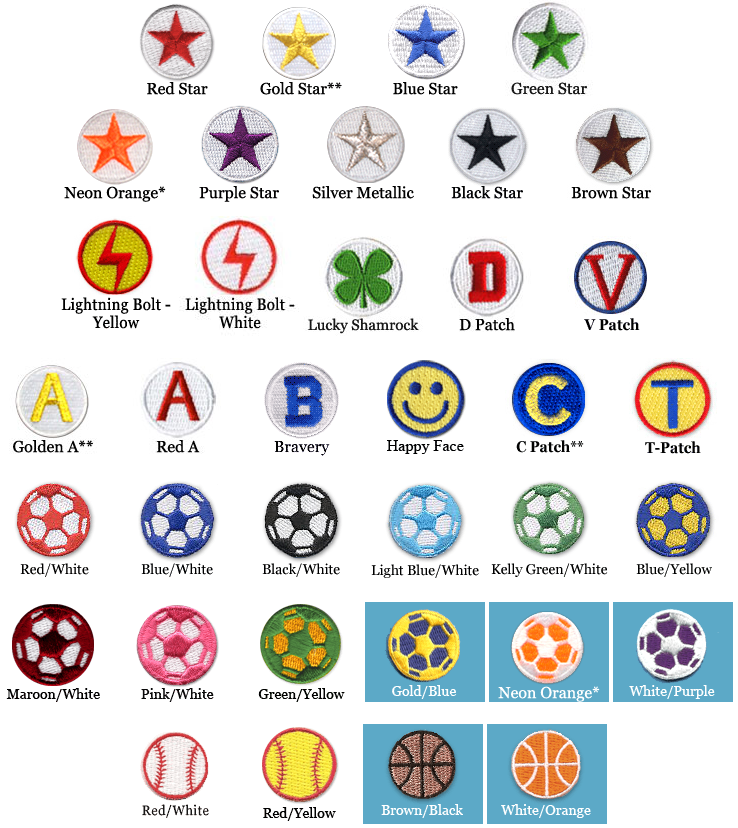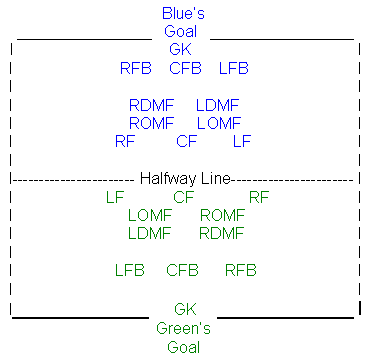Soccer Positions Basics & Kick-Offs
(The basics of soccer positions and how to teach soccer positions)
PREFACE: The difficulty of teaching Soccer Positions is that, except for Fullbacks at young ages, players often move around the field and don't stay in one spot. So, the positions are "relative" to each other, and generally when on Defense, the "left" side players should stay on the left side of the field, the "right" side players on the right side of the field (left and right are as you face the opposing Goalie), Fullbacks should be closer to their Goalie than their Midfielders are, and Midfielders should be closer to their Goalie than their Forwards are. These guidelines also apply when a team is on offense, but not as strictly. (Offense is more creative than defense and players may "overlap" in order to advance the attack; this is particularly true with Midfielders and Forwards, because most coaches may want their Fullbacks to be conservative and stay in a defensive position in case there is a counterattack by the opponent).
"Your stuff is the best I have ever read. I have been coaching for 35 years and wish I had your insights long ago." Scott, VT, Premium member
"I have learned more in the two weeks since subscribing to Premium than I learned in seven years of coaching."" Coach Rion, SC
"At every practice we religiously do Dribble Across a Square, Dribble Around A Cone and Pass, etc. - the poise my boys have on the ball is leaps and bounds above other teams now. Before, we were 4 wins 5 losses. Last season our record was 9 Wins 1 Tie." Coach T, U12 travel, MA, Premium member
Save $5 on SoccerHelp Premium. SoccerHelp Premium has 1,500 pages & 5,000 links for easy navigation. You can use the Coupon 5offpremium to subscribe to Premium for $10 for 30 days, $20 for 120 days, or $35 for a year. We do NOT automatically renew subscriptions. 15,000 Coaches have subscribed. 5-day money back guarantee. 1,000 Testimonials. Sign up at http://soccerhelp.com/members/signup
See photos of our 30 kinds of iron on Motivational Soccer Patches
Related Topics: (Scroll Down For "How To Teach Soccer Positions")
Diagrams of Soccer Positions & Soccer Formations
Youth Soccer Positions - How to Teach, Coach & Assign
How to Evaluate Players and Assign Soccer Positions
How to Evaluate Soccer Players and Choose a Soccer Formation
SoccerHelp Kick-Offs Navigation Page
SOME IMPORTANT TERMS: Following are some terms that we will use to help explain positions. These terms refer to parts of the field:
- "Center of the field" - The center of the field is the area between the 2 goals (as opposed to the "wings" or sides of the field where the sidelines are). The center of the field is where the "Center Fullback", "Center Midfielder" and "Center Forward" mostly play (you may not have Center positions in your "Formation"; if you play 7 or less on the field you may only have "Right" and "Left" positions). If you say "center it", you usually mean to kick the ball to the area in front of the goal.
- "Middle of the field" - The middle of the field is the area of the field that includes the "Halfway Line". Many coaches say "go to the middle" when they really mean "go to the center".
- "Attacking Third" - The Attacking Third is the third of the field that is closest to your opponent's goal (i.e., the goal the opposing Goalie defends). When your team attacks, you hope your Forwards and possibly your Midfielders get the ball into the Attacking Third. When your opponent is attacking your goal, you will probably not have any players in the Attacking Third, since your Midfielders will probably have dropped back near your "Penalty Box" line to help defend and your Forwards will have dropped back to the Halfway Line or to the inside of the "Center Circle" so they are in position to win "cleared" balls. (This "shifting and sagging" with the ball is very important so you have "support" on offense and defense).
- "Middle Third" - The Middle Third is the third of the field that includes the "Halfway Line" and the "Center Circle". When you attack, if your Fullbacks "Push Up" they will come up into the Middle Third. When your opponent is attacking your goal, your Forwards may come back into the Middle Third to the Halfway Line or even to the inside of the Center Circle so they are in position to win "cleared balls". (See "Push Up" in the Dictionary and "Should You Push Up When You Attack?" on the SoccerHelp Home Page).
- "Defensive Third" - The Defensive Third is the third of the field that includes your goal (your goal is the one your Goalie defends). Your Fullbacks will spend most of their time in the Defensive Third unless you have a good team and your Fullbacks "Push Up" when you attack. Your Midfielders will probably drop back into your Defensive Third to help out when your goal is under attack, but your Forwards should not come into your Defensive Third, because if they do there won't be anyone in position to win the ball when your Fullbacks or Midfielders "Clear" the ball.
BASIC POSITIONS: The number of players who play on the field varies greatly by age and league, and can range from 5 per team to a maximum of 11 per team. If there are only 5 on a team they may not have "Midfielders". Following are the basic positions for each team:
- One Goalkeeper ("GK").
- There is always just one Goalkeeper per team. The Goalie's job is to defend his team's goal and he usually stays close to his goal. You can identify the Goalie because he wears a different colored shirt or a vest over his shirt. As long as he is in the "Penalty Box" he can use his hands to pick up the ball, but if he comes out of the Penalty Box he cannot use his hands. (This is a very simplified description, read "Goalkeeper" in the Dictionary for more details). Except for "Throw-Ins" and to pick up the ball in "Re-Start" situations, the Goalie is the only player who can legally use his hands.
- Usually 2, 3 or 4 Defenders who are called Fullbacks ("FB").
- Fullbacks play closest to their goal (which is the goal their Goalie defends). Along with the Goalie, they have the primary job of stopping the opponents from scoring. However, to a degree, every player should be a "defender" when the opponent has the ball. One way to teach this is by teaching the concepts of "First Defender" and "Second Defender".
- Usually 2, 3 or 4 Midfielders ("MF").
- The Midfielders play between the Fullbacks and the Forwards. They are often in the "Middle Third" of the field. There can be "Offensive Midfielders" who play closer to the Forwards and "Defensive Midfielders" who play closer to the Fullbacks, as below.
- Usually 1, 2 or 3 Forwards ("F").
- Forwards play closer to the opponent's goal, which is the goal guarded by the opposing Goalie. The Forwards are the primary scorers, although Midfielders sometimes score and at older ages Fullbacks even occasionally score.
- There are also 2 special positions that some, but not all, teams use; a "Sweeper" and a "Stopper".
- A Sweeper will play behind the Fullbacks and a Stopper will play between the Fullbacks and the Midfielders. These positions add additional layers of defenders and give you defensive strength in the Center of the field. See "Sweeper" and "Stopper" in the Dictionary for a more detailed description.
LEGEND:

EXAMPLES OF WHERE PLAYERS MIGHT BE POSITIONED ON KICK-OFFS:
- The diagram below assumes 11 players per side (11 vs. 11) in a 3-2-2-3 formation and the "Green" team is kicking off. Blue is on defense. (Note: the "field" below is not to scale; see the "Field Diagram" for a better drawing of a field. See Notes, below.):
- The diagram below assumes 7 players per side (7 vs. 7) in a 2-2-2 formation and the "Green" team is kicking off. Blue is on defense. (Note: the "field" below is not to scale; see the "Field Diagram" for a better drawing of a field. Note that Green has moved the RF over to take the kick and that his plan is to kick the ball deep to the left corner, and then the RF, the LF and the 2 MF's will run toward the ball to try to steal it back. See Notes, below, and "Soccer Formations and Tips For 6 v 6"):

NOTES:
- If the Green team has good passing skills, they should spread their forwards and midfielders wider than shown above so they have more "width" in their attack. Otherwise, it is best to stay compact so they are in a good defensive position in case they turn over the ball. They should especially keep their Fullbacks compact to protect their goal.
- The receiving team must stay out of the "Center Circle" until the ball is moved by the kicking-off team.
- For young teams or weaker Rec teams, the greatest danger is the opponent attacking straight down the center of the field (i.e., going straight to goal). Thus, when on defense, it will be best for those teams to stay compact toward the center and to force the opponent to attack to the outside (down the sidelines or "wings").
- The diagrams above assume the Green team's plan is for a Forward (the CF in the 11 vs.11 diagram and the RF in the 7 vs. 7 diagram) to kick the ball deep to the corner so the Forwards and MF's can push up and try to win the ball back. This has the advantages of being simple to teach and of moving the ball away from your goal so you avoid the possibility of turning the ball over in the midfield. Our experience is that it isn't worth Recreational teams spending much time practicing kick-offs (there aren't many kick-offs and there are many more important things to practice). Kicking the ball to the corner is a perfectly acceptable strategy and you avoid the risk of turning over the ball and giving up an easy goal (we have even seen professional women's soccer teams kick the ball deep to the corner). See "Kick-Off" for more details.
See prices for our iron on Motivational Soccer Patches

